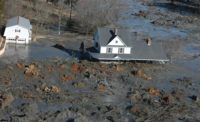The final significant legal chapter played out this month in the decade-long aftermath of a terrible gas explosion that killed four people and injured more than 60 others at a factory in Garner, N.C.
Judges in a courtroom 1,271 miles away in Lincoln, Neb. ruled that ConAgra, the owner of the plant where Slim Jims were made, owed Jacobs, the engineering powerhouse, more than $100 million that Jacobs and its insurers had paid to settle lawsuits from the explosion. The appeals court decisions upheld a jury verdict reached in March, 2016, following a long trial. The jury assigned all the blame to ConAgra and another contractor.
What is unusual is that Jacobs and its insurers made the payouts in lawsuit settlements despite Jacobs having little if anything to do with the disaster.
Jacobs was one of the defendants in the numerous lawsuits over the accident. But the case is unusual in that Jacobs and, presumably, its insurers made the payouts despite Jacobs having little if anything to do with the disaster.
ConAgra was updating the plant’s water heating system. After rejecting Jacobs proposal for the project as too costly, it hired the engineer to play a limited support role on the work. In the work agreement, ConAgra and Jacobs indemnified each other for damages caused by each parties’ own negligence.
ConAgra hired Energy Systems Analysts (ESA), a high-efficiency water heater contractor, to design and install a 5-million btu gas-fired water heater. And Jacobs designated an employee, Donald Pottner, as onsite project manager for its work. But two ConAgra employees—engineering manager Timothy Yost, and John Puff, the plant’s utilities manager—were supervising the work.
When the time came to commission the new water heating system, Pottner was ill and could not be present so ConAgra agreed to supervise that part of the work itself.
What happened next is a textbook example of why not to purge gas lines into the interior of a building, according to a report by the federal Chemical Safety Board.
Puff was responsible for determining the procedure to connect the new equipment to the plant’s gas supply, according to the account by the appeals court judges. On June 4, 2009, Puff instructed the crew to purge the line to the boiler with a hose leading outside, but he failed to provide the instruction to purge the line to the hot water tank. Puff stated that “[w]e just didn’t get to it.” Yost admitted the line to the hot water tank should have been purged before startup to prevent an explosive mixture.
At Yost’s direction on the next day, a ConAgra senior safety specialist inspected the pump room where the new water heater was located and reported “[e]xposed wires” as possible ignition source hazards. On June 9 an ESA employee, Curt Poppe, came to the plant to commission the water heater, but Puff did not provide the connection procedure to Poppe, the judges wrote, and no safety plan was created.
A ConAgra employee worked with him and unrated temporary lighting was brought into the room. Poppe had difficulty lighting the water heater, making 32 failed attempts. Over the next 3.5 hours he repeatedly cracked the valve on the pilot line and placed a gas meter in front as he released small streams of gas into the pump room to “bleed” the pipe.
Gas Odors Triggered Worry
Danger signs triggered mental alarms but not enough action. Employees smelled gas and worried whether the gas meter Poppe was using was functioning properly. Puff admitted he did not tell Poppe that the line had not been purged, even after Puff realized Poppe was struggling to light the heater.
The fateful moment approached.
According to the appeals judges, Puff interrupted the commission process so that he and Poppe could walk outside to allow Poppe to calibrate the gas meter in fresh air. Puff then left the plant to pick up supplies for another project. Puff left Poppe with another ConAgra employee even though Puff testified that he did not believe that person was qualified to supervise clearing air from a gas line. The employee thought something was wrong and went to the roof to try to locate an alternate purge point. Poppe returned to the pump room and released gas by opening the cap on the 2-in. gas pipe.
The room flooded with gas in less than 60 seconds. Puff admitted he “should have stayed around a lot longer” and had given the contractor “more credit’” than he should have. When asked about Poppe’s opening the cap on the gas pipe, Puff testified that if he had stayed, he “wouldn’t have allowed that.”
With the explosion, walls collapsed and the roof section fell. Altogether, four people died and 67 were injured.
Payouts Made in Lawsuits
Facing numerous lawsuits, Jacobs agreed at Conagra’s request to pay out settlements expecting to be reimbursed. But Conagra then said the indemnification didn’t apply, triggering Jacobs lawsuit against ConAgra in state court in 2014. Following a weeks-long trial in March 2016 with hundreds of exhibits and depositions, a jury awarded the contractor $108.9 million, the full amount of the settlements.
ConAgra continued to resist paying. Attorneys for each side recently faced off in Lincoln, Neb. in front the appeals court judges.
ConAgra’s attorney, Christopher Landau, argued that the district court erred because ConAgra’s liability should be limited to what it would owe under the state’s workers’ compensation laws. “It’s an end-run around the workers compensation system,” he said.
Jacobs failed to prove that its losses resulted from ConAgra’s negligence, he said, or others “under its control.”
Finally, Jacobs didn’t qualify as a real party in interest with standing to seek indemnification by documenting exactly what it paid in settlements or insurance payout. “I can’t see how you can affirm without knowing that they paid a penny,” Landau claimed.
Attorney Stephen B. Kinnaird, representing Jacobs, noted that the contract between the two companies plainly stated that ConAgra had a duty to indemnify for all claims caused by ConAgra’s negligence and by those under its control and that “Jacobs was only liable to extent of their negligence.”
Prior rulings in the various lawsuits over the explosion had shown that, while the insurance settlements had been redacted from the public record, the insurance policies in the record required Jacobs had a 10% copay or deductible of $35 million. In addition, Jacobs had an insurance tower—additional coverage that kicked in when lower levels were exhausted.
“The trial court found that more probably than not Jacobs paid part of the $109 million,” Kinnaird argued.
The North Carolina Dept. of Labor also found no negligence by Jacobs.
In its investigation of the disaster, the state wrote that Jacobs performed no work that could have contributed to the accident, had no knowledge of the hazardous condition and that its work scope deprived it of knowledge of the hazardous condition. The appeals court judges noted that ConAgra “accepted what the authorities determined” and did not conduct a separate investigation.
Two years after the explosion, ConAgra shut the plant and moved its operations to Ohio.






Post a comment to this article
Report Abusive Comment